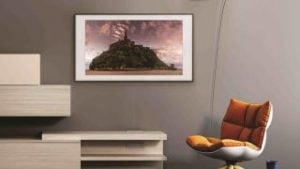Reports suggest that Samsung is currently working on a wireless TV. If it is successful, it would be the first of its kind. A patent has been submitted for the same. If Samsung comes through, there would no longer the need for the messy wires that come with the TV. The television will receive its energy from a wireless power transceiver in the form of a soundbar. This could be placed anywhere nearby. It will work remotely, eliminating the need for wires.
LetsGoDigital is a Dutch tech blog that first noticed the patent filed by Samsung for the wireless smart television. It was first submitted in 2018, but only recently became public. Among the multiple patents the company is working on, this was one of them. It looks like Samsung is working on plenty of options, including a smart mirror TV and even a roll-up TV!

At CES 2020, Samsung exhibited their zero-bezel TV. It offers an incredibly immersive viewing experience on different models. While the number of models has not been mentioned yet, the company is expected to release the zero-bezel TVs with displays measuring 65 inches and larger. Instead of the display panel being welded along the frame, it is welded only to the main body. While may have expressed concerns, Samsung seems assured about the structural integrity of this model. Manufacturing partners are Shinsegye Engineering and Taehwa Precision.
Samsung TVs
Samsung, the South Korean electronics giant, has started focusing on television sets over the last couple of years. They are working to find a way to seamlessly integrate TV sets into our homes. Last year, the company added a new featured called Ambient Mode to its QLED TVs. This feature enabled the screen to blend into the wall behind it.

According to a statement issued by the company, “TVs are turns on for only five hours a day on average, yet they occupy a large space on the wall in the living room. This means TVs hang on the wall just as a black screen for more than 19 hours every day. With a TV turned off, it is easier to see dust or fingerprints on the screen – especially when the screen is large.”
The visual impact is always spoilt by the numerous wires behind the TV that sticks out like a sore thumb. Many efforts have been taken to minimise the visual impact, with high-end models now shipping with Samsung’s OneConnect box. Here, all the wires are bunched up into a single cable that can be then connected to the TV. While it is not the ideal solution, it is relatively better than the untidy collection of wires that is always present.
Samsung has already started using wireless power technology in some of its products, such as its flagship device, the Galaxy S10 range. So far, there has been no comment on when we will see the wireless television in the market. Samsung has not hinted at any potential releases.
